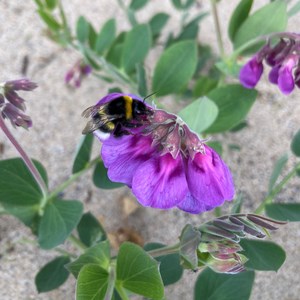Contact
Department of Crop Production Ecology, Crop production science
Department of Crop Production Ecology, Crop production science

The aim of this project is to identify native forage legume species that could be introduced as minor components of leys in northern Sweden by studying their morphology, forage quality, potential levels of anti-nutritional factors, response to cultivation and management, nitrogen fixation, and plant pollinator interactions. This project will serve to select species that will increase the biodiversity in leys.
Leys play an important role in food systems throughout Sweden, as they provide the forage necessary for dairy and meat production. In northern Sweden, these leys are generally monocultures, with red clover (Trifolium pratense L.) as the dominant forage legume species. Unfortunately, issues with root rot and clover rot negatively impact its persistence and such its yield in the long term. This poor persistence poses a problem in northern Sweden, as leys are often harvested for 3 or more years following sowing, meaning that the later years of harvest are far less productive, with far more variable yields. Ley persistence must be increased to fit the current management strategy in the region. A potential solution to this may be the inclusion of additional forage legume species with longer persistence.
The legume plant family has over 19,500 species, but only 65 species are commercially important and traded globally, 50 of which are forage legumes. This suggests that some species with unique adaptations to their environment and great potential for cultivation may have been overlooked for use in agriculture. The inclusion of native forage legumes in leys to increase diversity has the potential to improve the persistence and sustainability of forage production. Before new species can be included in leys, however, they must be screened both for beneficial traits that would improve the production systems, as well as potential negative attributes. This screening step should focus on their agronomic potential and the ecosystem services they could provide.
Candidate forage legume species were selected by utilising dried plant specimens from the Umeå University Herbarium (UME). This was an ideal place to look for potential forage legumes as this herbarium collection consists of dried plants that have been collected by botanists from around Västerbotten and all of Sweden. A list of 79 species from the legume family occurring in northern Sweden was obtained from specimens at UME. We then used the dried plant specimens to study the morphology, flowering time range, habit, origin and relative abundance to narrow down a list of seven candidate species. Six of the seven species have record of previous use as a traditional forage outside of Sweden, though only on a small scale. The candidate species are Anthyllis vulneraria L. (Getväppling), Astragalus alpinus ssp. alpinus L. (Fjällvedel), Lathyrus japonicus Willd. (Strandvial), Lathyrus palustris L. (Kärrvial), Lathyrus pratensis L. (Gulvial), Vicia cracca L. (Kråkvicker), and Vicia sepium L. (Häckvicker).
The Artportalen species portal, operated by SLU, was used to find known populations of the seven species. During June and July of 2020, plant populations will be identified throughout Västerbotten and plants will be collected for future forage analysis and antinutritional factor analysis. Soil samples will also be collected from each population site for analysis and identification of bacteria. Between July-September 2020, seeds from each species are harvested from the previously confirmed populations. These seeds will undergo a germination analysis and in will be used in both a greenhouse experiment to study their morphology and antinutritional factors, as well as in a field experiment to study how more biodiverse leys will respond to cultivation and harvest.